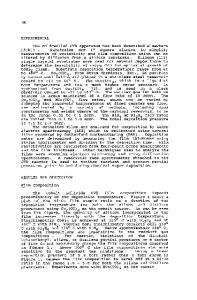In Situ , Real-Time Curvature Imaging During Chemical Vapor Deposition
- PDF / 133,481 Bytes
- 6 Pages / 612 x 792 pts (letter) Page_size
- 94 Downloads / 308 Views
U5.31.1
In Situ, Real-Time Curvature Imaging During Chemical Vapor Deposition David A. Boyd, Ashok B. Tripathi, Mohamed El-Naggar, and David G. Goodwin Division of Engineering and Applied Science California Institute of Technology Pasadena, CA 91125 Abstract Coherent Gradient Sensing (CGS) is a full-field optical technique that produces real-time images of macroscopic wafer curvature, which, for thin films, can be related to stress through Stoney’s equation. Here we describe the use of CGS as an in situ diagnostic to observe film stress distributions during chemical vapor deposition. The application of this method to measure oxygen diffusion rates in thin film YBa2 Cu3 O6+δ (YBCO) and stresses in thin film Pbx Ba1−x TiO3 (PBT) under chemical vapor deposition (CVD) conditions will be discussed. Introduction Control of stress is an issue facing a wide range of thin film applications such as micro-electronics, integrated optical devices, and micro-mechanical devices. Chemical Vapor Deposition (CVD) is regarded as one of the most cost-effective means of high-throughput, high-quality thin film deposition for these types of devices. In situ monitoring of stress during deposition and subsequent thermal cycling is a possible step towards understanding the evolution of thin film stress and the process conditions to control it. For many material systems there are relationships between the film’s microstructure and the macroscopic stress. For example, as oxygen absorbs or desorbs in a YBCO film there is a volume change and because the film is constrained laterally by the substrate, a corresponding change in the stress state. Techniques such as XRD, RHEED, and XTEM, which are indispensable for determining film microstructure, are not always feasible or available to the researcher for in situ studies, especially during CVD. Film stress can also be related to the macroscopic wafer curvature using Stoney’s formula [1]. This is a complimentary method which requires no knowledge of the film’s microstructure or its elastic properties. Curvature measurements are especially valuable in material systems where there are relaxation mechanisms or phase boundaries, and it is not always clear how the microstructure is related to the resultant macroscopic stress. There are a number of suitable optical techniques to measure wafer curvature. Traditional interferometric methods such as Michelson interferometry and shadow moiré allow imaging. However, there is limited use of these for in situ measurements because they are highly susceptible to vibrations. Multiple-beam methods have been used for in situ studies [2]. A drawback to these is the lack of spatial resolution, which may be desirable for examining patterned lines. In this paper, we demonstrate a relatively simple optical technique, CGS, to measure wafer curvature of two different material systems in a working MOCVD reactor. CGS combines the imaging capabilities of traditional interferometry and the vibration insensitivity of the multiple-beam methods. We monitor the oxygen diffusion rat
Data Loading...









